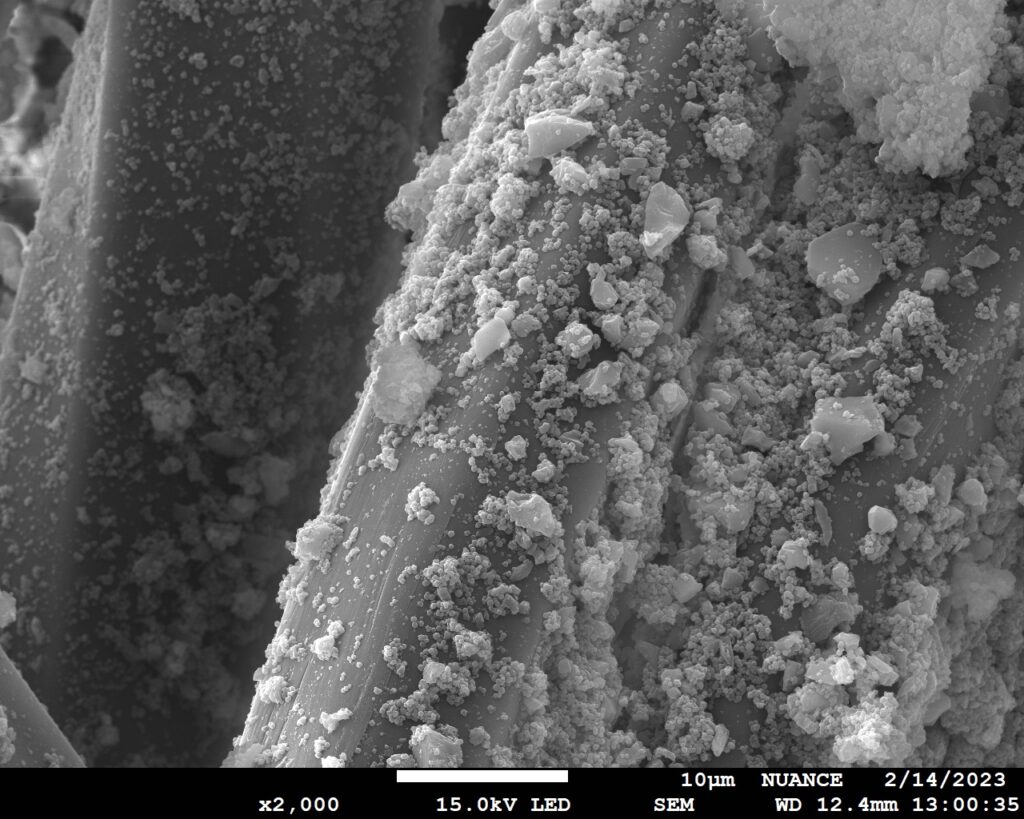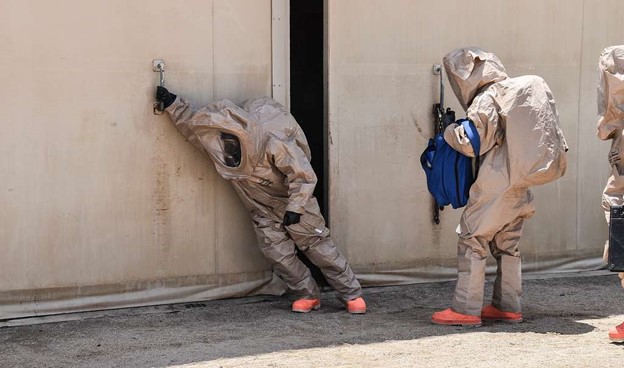Medical and military needs are coming together in a shared requirement for fabrics that offer protection against biological threats in healthcare environments and, for warfighters, the threat posed by chemical warfare. The challenges faced are complex; protection against multiple agents could be needed, and the agents may even be unknown. Against such obstacles, the development process for chemical, fiber and fabric technologies have to incorporate flexibility to allow for change as new challenges emerge—as they most certainly will.
Toxic nerve agents

Photo: Northwestern University.
Omar Farha is a professor and expert in metal-organic frameworks (MOFs) at Northwestern University. He and his colleagues at the university, working with Hong Kong Polytechnic University, have built on his earlier study on nanomaterials to deactivate toxic nerve agents, to develop a regenerative and multifunctional N-chlorine-based biocidal and detoxifying textile using a robust zirconium MOF.
The material is likened to a sophisticated bath sponge, housing a complex series of holes capable of capturing gases, vapors and other agents in the same way that a sponge traps and holds water. The cavities in the MOF contain catalysts that deactivate the toxic chemicals, viruses and bacteria.
“Having a bifunctional material that has the ability to deactivate both chemical and biological toxic agents is crucial since the complexity [needed] to integrate multiple materials to do the job is high,” Farah says.
In this new development, the researchers found that the MOF/fiber composite responds quickly to exposure to SARS-CoV-2 and both gram-negative bacteria (E.coli) and gram-positive bacteria (S.aureus). A chlorine-loaded MOF/fiber was shown to cause rapid degradation to sulfur mustard gas and 2-chlorethyl ethyl sulfide (CEES) that acts as its chemical stimulant.
Important for long periods of use, the nanopores of the MOF when coated on textiles are allowing the material to be breathable. Used as a face mask for instance, it would allow protection to the wearer from virus exposure, as well as protection to others when worn by an infected person.
The permeability problem
M.A. Rahman Bhuiyan and colleagues at RMIT (Royal Melbourne Institute of Technology), and the Australian Department of Defence have undertaken research into chemical protective clothing (CPC) and textiles, highlighting advances as well as issues that still have to be overcome. One persistent problem is permeability.
While impermeable coatings and laminates such as polyethylene and poly(vinylidene chloride) (PVDC) can provide effective barriers against chemical liquids, vapors and aerosols, their lack of breathability can cause the buildup of body heat leading to heat stress. The well-designed CPC suit needs to balance performance with comfort so that a single suit can demand multiple functionality from the textiles, including permeability, impermeability, semi-permeability and air-permeability.
The selectively permeable membrane (SPM) is designed to allow permeation of water molecules but not organic molecules. The SPM works by a process of continuous evaporative cooling that lowers the body temperature, reducing heat stress while protecting against toxic chemicals.

An example of the advances in CPC suits is the U.S. Military’s Joint Services Lightweight Integrated Suit Technology (JSLIST). This is an overgarment designed to protect active service personnel from chemical and biological agents. Lighter and less bulky than previous garments, it can provide 24 hours of protection against chemical liquid and vapor attack, it’s durable for 45 days and can be laundered up to six times.
Arguably, as dangerous as the things that we know about chemical protection are, the things we think we know can be just as dangerous. Materials that we know offer great protection in one area may offer little in others. In Joe Geng’s book, Rethinking Hand Safety published by his company Superior Gloves, he writes that leather is great for many kinds of work gloves, but for chemical protection it is “nearly as porous as human skin to dangerous chemicals.”
Dangerous chemicals can soak through aramids, for example, but provide excellent protection against cuts. The needs of the worker are often multiple as is evident by many of the descriptions on Superior Glove’s website, such as coated gloves for dry chemical protection and secure grip; chemical-resistant with nitrile palm coating for wet grip; nitrile gloves with ceramic powder grip finish for wet and oily conditions.
Winter protection Geng describes as particularly challenging, often needing multiple layers to stay warm, but needing moisture management, then adding additional requirements, such as cut-resistance, dexterity and launderability.
Vapor hazards
Not all chemical dangers are visible to the human eye. Researchers at North Carolina State University are using a Man-in-Simulant-Test (MIST) to assess the effectiveness of textiles against chemical vapor hazards. Tests are performed with human subjects undertaking a moderate level of exercise while wearing the clothing to be tested with adsorptive patches placed directly onto the skin. A controlled concentrate of the non-toxic Methyl salicylate (MeS), also referred to as oil of wintergreen, is used as the chemical vapour in MIST.
The facility is the only one of its kind in the United States and is located in the university’s Textile Protection and Comfort Center (TPACC), for use in testing protective apparel against chemical and biological threats. Just as the chemicals may be invisible, the ability of textiles to withstand threats can also be hard to detect. These include the permeation of the chemical through the clothing, as well as the penetration and build-up of the hazards over time and the degradation of protective textiles.
As Geng says, “no chemical-resistant glove will keep the bad stuff out forever. You need to know how long a resistant glove can hold out, and when it needs to be thrown away.”
Dr. Marie O’Mahony is an industry consultant, author and academic based in London. She the author of several books on advanced and smart textiles published by Thames and Hudson and a frequent contributor to Textile Technology Source.
 TEXTILES.ORG
TEXTILES.ORG


